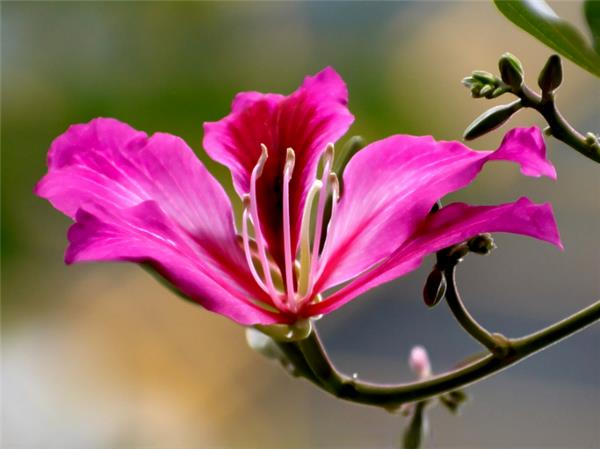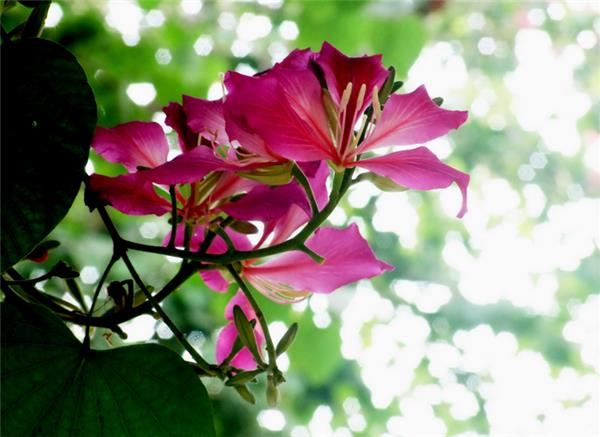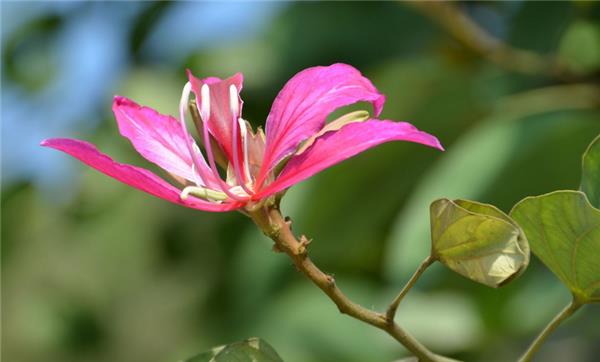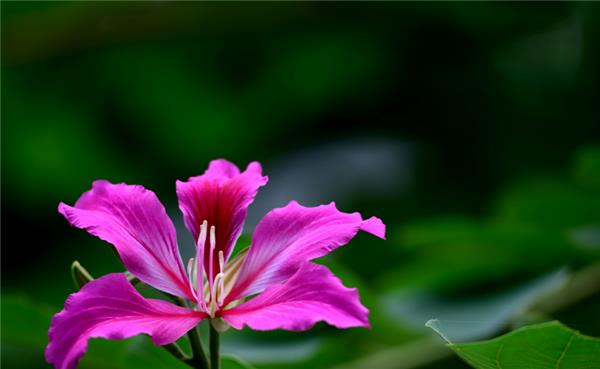There are ways to cultivate beautiful bauhinia in Bauhinia planting
The bauhinia is loved by the majority of flower lovers because of its bright and beautiful colors, so what are the planting methods of bauhinia?

1. Introduction of Bauhinia:
Bauhinia is also called Mantiaohong, Sufang flower, purple plant, black mulberry, basket of trees. It is a deciduous shrub or small tree of the genus Bauhinia in Leguminosae. It is one of the main ornamental flowers in spring. It likes sunshine and is resistant to heat. The trunk is straight and clumpy, the flowers bloom before the leaves in early spring, the flowers are like butterflies, and when they are in full bloom, they are numerous, clustered and close to the branches, and the trees are full of flowers, which can bloom not only on the branches, but also on the old trunks, giving people the feeling of blooming; in summer and autumn, the green leaves are whirling and the eyes are green. After the defoliation in winter, the branches show their muscles and bones, and the feeling of vigorous Qiu qu is in front of us. It is a garden with excellent flowers, leaves and stems, suitable for planting in courtyards, parks, squares, lawns, street gardens, road green belts, etc., and can also be potted to watch or make bonsai.
Another: the Hong Kong Special Administrative region flower Bauhinia, also known as Bauhinia, but very different from this species. The bauhinia on the Hong Kong regional flag and emblem is white. White-flowered bauhinia is very rare, so it is very valuable.

Second, the cultivation of bauhinia:
The propagation of Bauhinia is commonly used in the methods of sowing, dividing, pressing and cutting. For excellent varieties such as Canadian red-leaf bauhinia, it can also be propagated by grafting.
1. Sowing seeds
Collect mature pods from September to October, take out the seeds, bury them in dry sand and place them in a cool place to survive the winter. The seeds were sown from late March to early April, and the seeds were treated before sowing. Only in this way can the seedlings be strong. Soak the seeds in 60 ℃ warm water and continue soaking for 3 to 5 days after cooling. It is necessary to change cold water once a day. After absorbing and expanding, the seeds are placed in 15 ℃ environment to accelerate germination, drench with warm water once or twice a day, and sow in the seedling bed after whitening. Seedlings can be completed in 2 weeks, and seedlings can be properly separated after emergence. 4 true leaves can be transplanted in the nursery, and the loose and fertile loam is better in the border land. In order to facilitate management, planting implements wide and narrow rows, with a wide row of 60 cm, a narrow row of 40 m, and a plant spacing of 30 to 40 m. It is not cold-resistant in seedling stage, and plastic arch shed should be used to protect it in winter.
two。 Ramet
The root of Bauhinia is easy to produce tillers. It is easy to survive by replanting the lateral root connected with the mother plant with a sharp knife before sprouting in October or spring. The ramets should be protected in winter in autumn and planted in March in spring. It can usually blossom in the second year.

3. Pressing strip
The growing season can be carried out, and it is better from March to April in spring. The air pressing method can choose 1-2-year-old branches, cut with a sharp knife and peel the bark around 1.5 cm, expose the xylem, and apply the rooting powder solution (diluted according to the instructions) to about 3 cm above the burn site. After drying, cover the cut with a barrel-shaped plastic bag, fill it with loose garden soil, and tie both ends tightly after watering. Check after one month, if the soil is too dry, it can replenish water and moisturize, cut off and plant again after taking root. Shrub trees can choose soft, 1-to 2-year-old branches to cut the base, coated with rooting powder, buried in the soil after sharp bending, pressed masonry, and the top can be righted with sticks. It is generally divided and replanted in March of the following year. Some branches do not take root in that year, but can continue to be buried and can take root the next year.
4. Barge in
In the summer growing season, cut off the current year's twigs to do cuttings, inserted in the sand can also survive, but not commonly used in production.

5. Grafting
Ordinary bauhinia and giant bauhinia can be used as rootstocks, but the cold resistance of giant bauhinia is not strong, so it is not suitable for use in the north. The buds or branches of excellent varieties such as Canadian red-leaf bauhinia are used as scions, the scion requires pure varieties and vigorous growth, select the full branches around the sunny side of the plants with no or less diseases and insect pests, cut off the leaves after the scion is collected, and grafting in time. The method of branch grafting can be used from April to May and from August to September, and bud grafting can be used in July. If the weather is dry, permeable water should be irrigated 1 to 2 days before grafting to improve the survival rate of grafting. The survival of the scion should be checked about 3 weeks after bauhinia grafting, and timely replacement should be carried out if it does not survive. The grafted plants should wipe off the germinated branches and buds on the rootstock in time, so as not to compete for nutrients with the scion and affect its normal growth.
The above is the relevant knowledge of Bauhinia, I hope I can help you.
- Prev

The efficacy and function of Aloe Vera is of great use in cultivating Aloe vera.
The efficacy and function of Aloe Vera is of great use in cultivating Aloe vera.
- Next

Species and culture of daffodils how to make daffodils "bloom as they please"
Species and culture of daffodils how to make daffodils "bloom as they please"
Related
- Wuhan Hospital Iron Tree Blooming Result Was Instantly Frightened by the Gardener Master
- Which variety of camellia is the most fragrant and best? Which one do you like best?
- What is the small blue coat, the breeding methods and matters needing attention of the succulent plant
- Dormancy time and maintenance management of succulent plants during dormancy
- Minas succulent how to raise, Minas succulent plant pictures
- What are the varieties of winter succulent plants
- How to raise succulent plants in twelve rolls? let's take a look at some experience of breeding twelve rolls.
- Attention should be paid to water control for succulent plants during dormant period (winter and summer)
- Watering experience of twelve rolls of succulent plants
- Techniques for fertilizing succulent plants. An article will let you know how to fertilize succulent plants.

